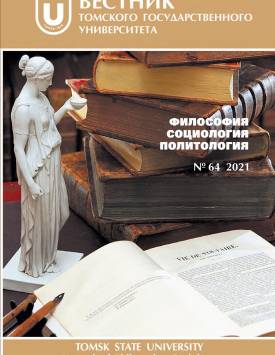The Logic of Action as a Tool for Analyzing and Solving Philosophical Problems
The article investigates the question about the possibility of treating contemporary logic with its methods of analysis and its discipline-specific subjects as a tool that can be used efficiently and comfortably by specialists in philosophy. From this point of view, I firstly investigate the methods of the logic of action - one of the branch of contemporary logic - and then demonstrate how the arsenal of the logic of action can be applied in the field of philosophy today. Firstly, I demonstrate the richness of the logic of action methods by expressing with the means of classical semantics of the notion of the agentive degree or the degree of agency. Secondly, by using the set-theoretical approach, I point out the new way of development for the logic of action that lies in the traditional area of philosophical knowledge. Here I argue that it is possible to regard as a new subject for the logic of action the selfward actions and the structures of so-called agentive domains, or the sets of state of affairs that can be put into existence via agentive actions. In the conclusion, I claim that the logic of action, or, following my proposal, the logic of choice with its methods will be well adopted into the set of investigation practices of those who are professionals in the realm of philosophy.
Keywords
logic of action,
philosophical question,
agent,
logical semantics,
refrainingAuthors
| Karpov Gleb V. | Saint Petersburg State University | glebsight@gmail.com |
Всего: 1
References
Plantinga A. The Nature of Necessity. Oxford : Oxford University Press, 1974. 255 p.
Girle R. Modal Logics and Philosophy, 2009. 240 p.
Garson J. Modal Logic for Philosophers. Cambridge University Press, 2006. 506 p.
Segerberg K., Meyer J.-J., Kracht M. The Logic of Action // The Stanford Encyclopedia of Philosophy / ed. by E.N. Zalta. URL: https://plato.stanford.edu/archives/sum2020/entries/logic-action (accessed: 15.05.2020).
Lorini E., Sartor G. A STIT Logic for Reasoning About Social Influence // Studia Logica. 2016. 104. P. 773-812.
Broersen J. Deontic epistemic stit logic distinguishing modes of mens rea // Journal of Applied Logic. 2011. Vol. 9. P. 137-152.
Belnap N. Backwards and forwards in the modal logic of agency // Philosophy and Phenomenological Research. 1991. Vol. 51, № 4. P. 777-807.
Chellas B.F. Time and Modality in the Logic of Agency // Studia Logica: An International Journal for Symbolic Logic. 1992. Vol. 51, № 3/4, Logic of Action. P. 485-517.
Horty J.F., Belnap N. The Deliberative Stit: A Study of Action, Omission, Ability, and Obligation // Journal of Philosophical Logic. Dec., 1995. Vol. 24, № 6. P. 583-644.
Ciuni R., Lorini E.Comparing Semantics for Temporal Stit Logic // Logique Et Analyse. 2018. Issue 243. P. 299-339.
Xu M. Axioms for Deliberative “Stit” // Journal of Philosophical Logic. Oct., 1998. Vol. 27, № 5. P. 505-552.
Payette G. Decidability of an Xstit Logic // Studia Logica. 2014. 102. P. 577-607.
Xu M. Decidability of Stit Theory with a Single Agent and Refref Equivalence // Studia Logica. 1994. 53. P. 259-298.
Balbiani P., Herzig A., Troquard N. Alternative Axiomatics And Complexity Of Deliberative Stit Theories // Journal Of Philosophical Logic. August 2008. Vol. 37, № 4. P. 387-406.
Benthem J. van, Pacuit E. Connecting Logics of Choice and Change // Nuel Belnap on Indeterminism and Free Action / ed. by T. Muller. Springer, 2014. P. 291-314.
Broersen J. A complete STIT logic for knowledge and action, and some of its applications / eds. M. Baldoni, T.C. Son, M.B. van Riemsdijk, M. Winikoff // Declarative Agent Languages and Technologies VI. DALT 2008. Lecture Notes in Computer Science, vol 5397. Springer, Berlin, Heidelberg. P. 47-59.
Блинов А.Л., Петров В.В. Элементы логики действий. М. : Наука, 1991. 232 с.
Logie R.D. A Study of Agent Influence in Nested Agent Interactions. PhD thesis. The Open University, 2010. 270 p. URL: http://oro.open.ac.uk/62023/ (accessed: 20.06.2020).
Dennett D. Higher-order truths about chmess. Topoi, 2006. P. 39-41.

